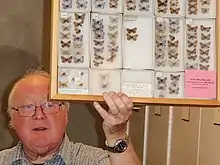Xerces blue
The Xerces blue (Glaucopsyche xerces) is a recently extinct species of butterfly in the gossamer-winged butterfly family, Lycaenidae. The species lived in coastal sand dunes of the Sunset District of the San Francisco Peninsula in California. The Xerces blue is believed to be the first American butterfly species to become extinct as a result of loss of habitat caused by urban development. The last Xerces blue was seen in 1941 or 1943[3] on land that is now part of the Golden Gate National Recreation Area.[4]
| Xerces blue | |
|---|---|
 | |
| Samples of the extinct Glaucopsyche xerces butterfly in the collections of the Field Museum of Natural History | |
| Scientific classification | |
| Domain: | Eukaryota |
| Kingdom: | Animalia |
| Phylum: | Arthropoda |
| Class: | Insecta |
| Order: | Lepidoptera |
| Family: | Lycaenidae |
| Genus: | Glaucopsyche |
| Species: | †G. xerces |
| Binomial name | |
| †Glaucopsyche xerces (Boisduval, 1852) | |
| Synonyms | |
| |
Name
The specific name derives from the French spelling of "Xerxes", the Greek name of the Persian kings Xerxes I and Xerxes II of the fifth century BC.[5] An endangered invertebrate conservation group known as the Xerces Society is named after the Xerces blue.[6][7]

Extinction and ecology
The species was first described and documented in 1852.[8] It was characterized by blue wings with white spots.[9] The butterflies fed on vegetation belonging to the genus Lotus and Lupinus.[9] The loss of the Lotus plant that the butterfly fed on while in its larval stages is believed to be one reason for the extinction of the Xerces blue. The plant could not survive in the disturbed soils due to human development, and was no longer available to the Xerces blue.[8][9] Lupin, Xerces blue's other vegetative food source, was not suitable for the larval stages.[9]
Preserved specimens are found in California Academy of Sciences, Bohart museum, and the Harvard Museum of Natural History.[8]
Reestablishment efforts
Efforts are on to reestablish related butterflies in the Xerces blue's former habitat. The Palos Verdes blue (Glaucopsyche lygdamus palosverdesensis), which is considered a Los Angeles cousin of the Xerces, is being reared in labs. A new Xerces-like subspecies of the silvery blue (Glaucopsyche lygdamus), which the Xerces blue was thought to be a subspecies of[10] has been discovered as well, and is being analyzed as a potential way to revive the Xerces blue.[11]
In October & December 2021, two entomologists from Jabalpur, India, believed they spotted surviving examples of Xerces blue in Madhya Pradesh.[12] The entomologists collected samples and compared them against images of specimens preserved at the Florida Museum of Natural History.[12] There have been no further reports of surviving examples.
References
- World Conservation Monitoring Centre (1996). "Glaucopsyche xerces". IUCN Red List of Threatened Species. 1996: e.T9244A12971422. doi:10.2305/IUCN.UK.1996.RLTS.T9244A12971422.en. Retrieved 20 November 2021.
- "NatureServe Explorer 2.0". explorer.natureserve.org. Retrieved 1 November 2022.
- Powell, J.A.; Hogue, C.L. (1979). California Insects. University of California Press. ISBN 978-0-520-03782-3.
- Garth, J.S.; Tilden, J.W. (1986). California Butterflies. University of California Press. ISBN 0520052498.
- "xerxes | Origin and meaning of xerxes by Online Etymology Dictionary". www.etymonline.com. Retrieved 2021-02-20.
- "About the Xerces Society | Xerces Society". xerces.org. Retrieved 2021-02-20.
- "Mission". www.guidestar.org. Retrieved 2021-02-20.
- Resources, University of California Agriculture and Natural. "And Then There Were None: Bohart Museum Remembering Xerces Blue Butterfly In Effort to Help Preserve Other Species". entomology.ucdavis.edu. Retrieved 2017-04-13.
- Tilden, J. W. (1956). "San Francisco's Vanishing Butterflies" (PDF). The Lepidopterists' News: 113–115.
- Grewe, Felix; Kronforst, Marcus R.; Pierce, Naomi E.; Moreau, Corrie S. (2021). "Museum genomics reveals the Xerces blue butterfly ( Glaucopsyche xerces ) was a distinct species driven to extinction". Biology Letters. 17 (7). doi:10.1098/rsbl.2021.0123. PMC 8292013. PMID 34283930. S2CID 236144945.
- "Wild Genomes - Awarded Projects - Revive & Restore".
- "Butterfly species thought to be extinct found in Madhya Pradesh". The New Indian Express. 13 January 2022. Retrieved August 25, 2023.

